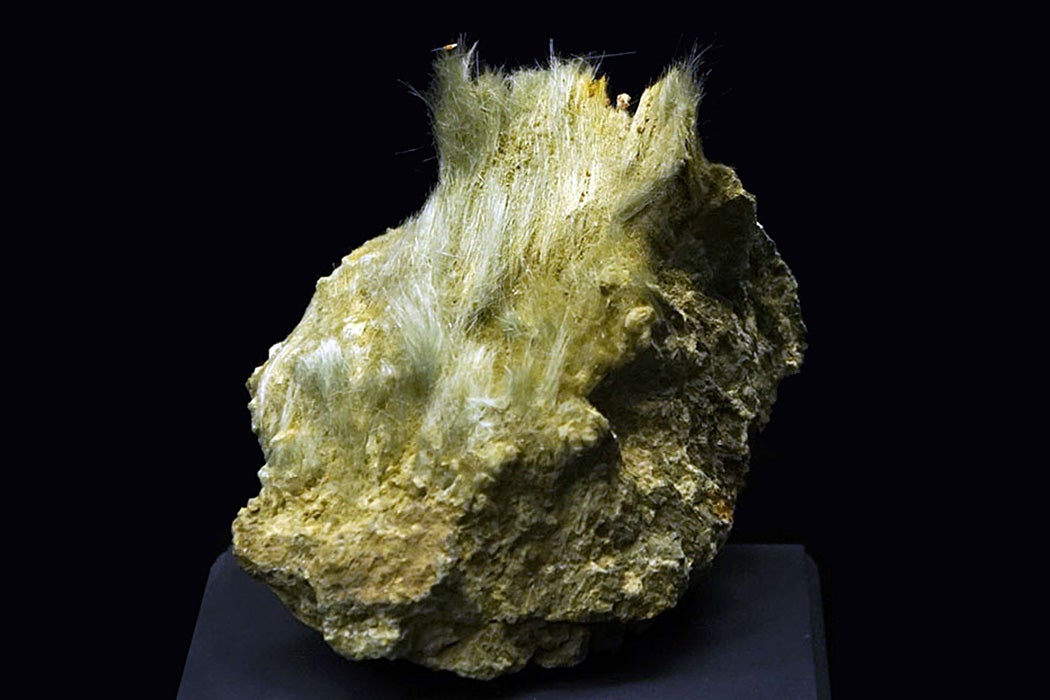According to legend, Charlemagne liked to lay out his lavish banquets on a sparkling-white tablecloth spun from pure asbestos. After his guests had eaten their fill, the king would pluck the tablecloth off the table and fling it into the hearth. In the blaze, the cloth turned fiery red, but did not burn. When it was plucked out, it was cleaner than ever, with the debris of the meal roasted away.
Long before asbestos was recognized as a health hazard, it was a near-mythical wonder material, a gift fit for kings and emperors. One Han dynasty general apparently put on an even better show than Charlemagne: he would wear an asbestos jacket to dinner and “accidentally” spill wine over it. Feigning a fit of rage, he would rip off the garment and throw it into the fire, only to pull it out moments later, perfectly clean and unharmed.
Nobles were cremated in asbestos shrouds, so that their ashes would not mix with the cinders of the fire. The eternal flames that burned in the temples of Vesta, watched over by the Vestal virgins, were kindled on asbestos wicks.
But asbestos was also turned to less scrupulous uses. The wondrous properties of the material made it a prime tool for the creation of false relics: its incombustibility served as proof of authenticity. Scammers passed off chunks of asbestos as fragments of the True Cross, and the monks of Monte Cassino bought an asbestos towel under the impression that it was the cloth Jesus had used to wash his disciples’ feet.

But even without trickery, asbestos was rare and precious enough to fetch a pretty penny. When Benjamin Franklin found himself broke in London, he paid his bills by selling an asbestos purse to a curiosity-collector. We still have his letter:
Sir, Having lately been in the Northern Parts of America, I have brought from thence a Purse made of the Stone Asbestus, a Piece of the Stone, and a Piece of Wood, the Pithy Part of which is of the same Nature, and call’d by the Inhabitants Salamander Cotton. As you are noted to be a Lover of Curiosities, I have inform’d you of these; and if you have any Inclination to purchase them, or see ’em, let me know your Pleasure by a Line directed for me at the Golden Fan in Little Britain, and I will wait upon you with them.
Asbestos seemed to belong more to the realm of fairy-tales than to real life. Some believed that it was derived from the wool of the mythical fire-resistant salamander, or the feathers of the phoenix. Others confidently claimed that it was spun from the long, silky fur of a species of rat that lives inside volcanoes. According to this version of the legend, while the rats are in the blaze, their hairs glow sapphire-red. Hunters kill them by splashing them with just a few drops of water, after which their fur fades to an alabaster white.
Weekly Newsletter
These stories may seem a little far-fetched, but there’s a certain logic to them—after all, it makes sense that the source of an incombustible fiber would be incombustible itself. The truth of asbestos is perhaps even stranger. As the historian of technology Rachel Maines notes in Asbestos and Fire: Technological Tradeoffs and the Body at Risk, pretty much every fiber we use comes from something living, whether animal or vegetable. Asbestos is the only exception; it’s the only rock that can be woven into cloth. For that reason, the early naturalist Charles Bonnet considered asbestos to be the missing link between lifeless rock and living matter.
There is something extremely eerie about asbestos in the wild. Splitting open a rock, you discover a vein of fluff running through it, like wool caught in a cleft. A blue-gold glimmer of chatoyancy runs down the threads, and when you peel the fibers away, they come off as delicately as pieces of cobweb. Rock as delicate as silk, cloth as indestructible as rock: asbestos seems like it should be impossible. If you came across this description in an old book of natural wonders, you’d probably dismiss it as a legend, just as unlikely as the fire-resistant salamander or the fire-rat.
Support JSTOR Daily! Join our new membership program on Patreon today.







